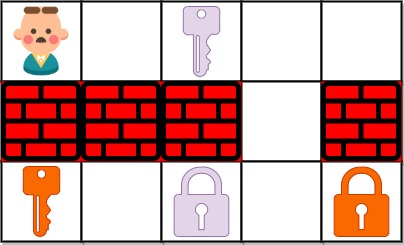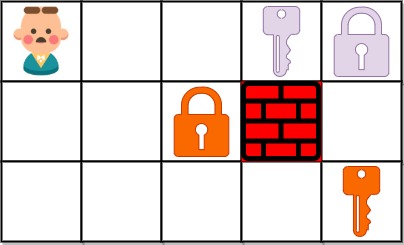Shortest Path to Get All Keys
HardYou are given an m x n grid grid where:
'.'is an empty cell.'#'is a wall.'@'is the starting point.- Lowercase letters represent keys.
- Uppercase letters represent locks.
You start at the starting point and one move consists of walking one space in one of the four cardinal directions. You cannot walk outside the grid, or walk into a wall.
If you walk over a key, you can pick it up and you cannot walk over a lock unless you have its corresponding key.
For some 1 <= k <= 6, there is exactly one lowercase and one uppercase letter of the first k letters of the English alphabet in the grid. This means that there is exactly one key for each lock, and one lock for each key; and also that the letters used to represent the keys and locks were chosen in the same order as the English alphabet.
Return the lowest number of moves to acquire all keys. If it is impossible, return -1.
Example 1:

Input: grid = ["@.a..","###.#","b.A.B"] Output: 8 Explanation: Note that the goal is to obtain all the keys not to open all the locks.
Example 2:

Input: grid = ["@..aA","..B#.","....b"] Output: 6
Example 3:

Input: grid = ["@Aa"] Output: -1
Constraints:
m == grid.lengthn == grid[i].length1 <= m, n <= 30grid[i][j]is either an English letter,'.','#', or'@'.- There is exactly one
'@'in the grid. - The number of keys in the grid is in the range
[1, 6]. - Each key in the grid is unique.
- Each key in the grid has a matching lock.
Solution
Clarifying Questions
When you get asked this question in a real-life environment, it will often be ambiguous (especially at FAANG). Make sure to ask these questions in that case:
- What are the dimensions of the grid (rows and columns), and what are the maximum possible values?
- What characters can appear in the grid besides '.', '#', '@', lowercase letters, and uppercase letters? Are empty grids possible?
- If it's impossible to collect all the keys, what should I return?
- Are the lowercase and uppercase letters guaranteed to be paired (i.e., for every key 'a', there's a corresponding lock 'A')?
- Is it possible to start at a location where a key or lock is already present?
Brute Force Solution
Approach
The idea is to explore every possible path we can take through the maze. We keep going until we find the shortest one that lets us collect all the keys.
Here's how the algorithm would work step-by-step:
- Start at the initial location.
- Consider all possible moves: up, down, left, or right.
- For each possible move, check if we can actually move there (is it a wall?).
- If we can move there, move to the new location and check if we picked up a key or opened a lock.
- Remember which keys we have at each location.
- From the new location, again consider all possible moves and repeat the process.
- If we reach a location where we have all the keys, note the number of moves it took.
- Do this for every possible path we can take through the maze.
- After exploring all possible paths, compare the number of moves for each path that collected all the keys and select the path with the fewest moves.
Code Implementation
def shortest_path_all_keys_brute_force(grid):
rows = len(grid)
columns = len(grid[0])
start_row, start_column = -1, -1
all_keys = 0
# Find the starting position and calculate the total number of keys
for row in range(rows):
for column in range(columns):
if grid[row][column] == '@':
start_row, start_column = row, column
elif 'a' <= grid[row][column] <= 'z':
all_keys |= 1 << (ord(grid[row][column]) - ord('a'))
shortest_path = float('inf')
def explore(row, column, keys, moves):
nonlocal shortest_path
# Base case: If all keys are collected, update shortest path
if keys == all_keys:
shortest_path = min(shortest_path, moves)
return
if moves >= shortest_path:
return
# Define possible moves: up, down, left, right
possible_moves = [(0, 1), (0, -1), (1, 0), (-1, 0)]
for delta_row, delta_column in possible_moves:
new_row, new_column = row + delta_row, column + delta_column
# Boundary and wall check
if 0 <= new_row < rows and 0 <= new_column < columns and grid[new_row][new_column] != '#':
cell = grid[new_row][new_column]
new_keys = keys
# Key pickup
if 'a' <= cell <= 'z':
key_index = ord(cell) - ord('a')
new_keys |= (1 << key_index)
# Lock check
if 'A' <= cell <= 'Z':
lock_index = ord(cell) - ord('A')
if not (keys & (1 << lock_index)):
continue
# Explore the next possible state
explore(new_row, new_column, new_keys, moves + 1)
explore(start_row, start_column, 0, 0)
if shortest_path == float('inf'):
return -1
else:
return shortest_pathBig(O) Analysis
Optimal Solution
Approach
The problem is like navigating a maze where you need to collect all the keys before reaching the exit. The efficient approach uses a clever search to explore the maze, remembering which keys you've already found at each location to avoid unnecessary backtracking and find the shortest path.
Here's how the algorithm would work step-by-step:
- Think of the maze as a series of rooms and hallways, and your goal is to visit all the rooms containing keys.
- Start at the starting point and explore outwards, one step at a time. Keep track of all the places you've visited and the keys you have when you visit them.
- When you encounter a locked door, check if you already have the key. If you do, open the door and continue exploring. If not, you'll need to find that key before coming back.
- To avoid going around in circles, always prioritize exploring new areas. If you find yourself revisiting the same location with the same set of keys as before, you can ignore that path.
- Continue exploring until you have found all the keys and reached the exit. The number of steps you took is the shortest path length.
- The trick is to remember where you've been and which keys you had at each location so you don't repeat any unnecessary steps.
Code Implementation
def shortest_path_all_keys(grid):
rows = len(grid)
cols = len(grid[0])
start_row, start_col = -1, -1
all_keys = 0
for row in range(rows):
for col in range(cols):
if grid[row][col] == '@':
start_row, start_col = row, col
elif 'a' <= grid[row][col] <= 'z':
all_keys |= (1 << (ord(grid[row][col]) - ord('a')))
queue = [(start_row, start_col, 0, 0)]
visited = set()
visited.add((start_row, start_col, 0))
steps = 0
while queue:
length = len(queue)
for _ in range(length):
row, col, keys, distance = queue.pop(0)
if keys == all_keys:
return steps
# Iterate through all possible directions.
for delta_row, delta_col in [(0, 1), (0, -1), (1, 0), (-1, 0)]:
new_row, new_col = row + delta_row, col + delta_col
if 0 <= new_row < rows and 0 <= new_col < cols and grid[new_row][new_col] != '#':
cell = grid[new_row][new_col]
# If the cell is a lock.
if 'A' <= cell <= 'Z':
key_index = ord(cell) - ord('A')
if not (keys & (1 << key_index)):
continue
new_keys = keys
# If the cell is a key.
if 'a' <= cell <= 'z':
key_index = ord(cell) - ord('a')
new_keys |= (1 << key_index)
# This check prevents revisiting states.
if (new_row, new_col, new_keys) not in visited:
visited.add((new_row, new_col, new_keys))
queue.append((new_row, new_col, new_keys, distance))
steps += 1
return -1Big(O) Analysis
Edge Cases
| Case | How to Handle |
|---|---|
| Empty grid | Return -1 immediately since there's no path. |
| Grid with no keys or locks | Return 0 immediately since the starting point is the solution. |
| Starting point blocked by a wall | Return -1 as no path can be initiated. |
| No path exists to collect all keys | Return -1 if the BFS queue empties before all keys are collected. |
| Maximum grid size (30x30) with many keys | BFS might consume significant memory; ensure the solution doesn't exceed memory limits. |
| The starting point is adjacent to all the locks, but far away from keys | The algorithm must handle the correct order of getting keys before reaching locks. |
| Grid contains a cycle that must be traversed to get to a key | The visited set in BFS handles cycles effectively by avoiding revisiting states. |
| Key-lock pairs are not matched; a key opens a lock of a different letter | The problem assumes matching key-lock pairs based on letter case; solution will only work with matching pairs, return -1 if no solution exists |